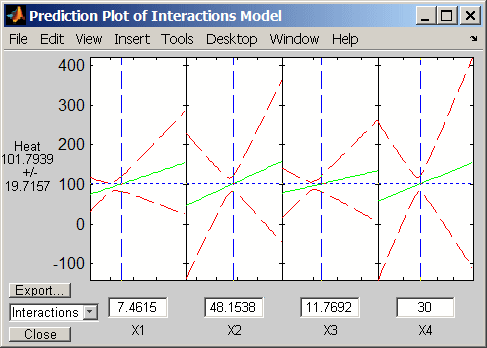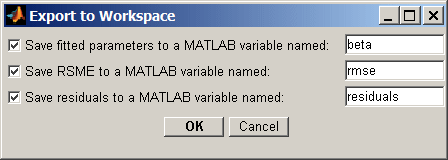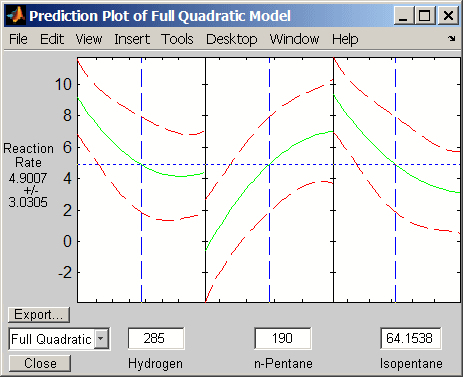rstool
Interactive response surface modeling
Syntax
rstool
rstool(X,Y,model)
rstool(x,y,model,alpha)
rstool(x,y,model,alpha,xname,yname)
Description
rstool opens a graphical
user interface for interactively investigating one-dimensional contours
of multidimensional response surface models.

By default, the interface opens with the data from hald.mat and
a fitted response surface with constant, linear, and interaction terms.
A sequence of plots is displayed, each showing a contour of
the response surface against a single predictor, with all other predictors
held fixed. rstool plots a 95% simultaneous confidence
band for the fitted response surface as two red curves. Predictor
values are displayed in the text boxes on the horizontal axis and
are marked by vertical dashed blue lines in the plots. Predictor values
are changed by editing the text boxes or by dragging the dashed blue
lines. When you change the value of a predictor, all plots update
to show the new point in predictor space.
The pop-up menu at the lower left of the interface allows you to choose among the following models:
Linear— Constant and linear terms (the default)Pure Quadratic— Constant, linear, and squared termsInteractions— Constant, linear, and interaction termsFull Quadratic— Constant, linear, interaction, and squared terms
Click Export to open the following dialog box:

The dialog box allows you to save information about the fit to MATLAB® workspace variables with valid names.
rstool(X,Y, opens
the interface with the predictor data in model)X, the
response data in Y, and the fitted model model.
Distinct predictor variables should appear in different columns of X. Y can
be a vector, corresponding to a single response, or a matrix, with
columns corresponding to multiple responses. Y must
have as many elements (or rows, if it is a matrix) as X has
rows.
The optional input model can be any
one of the following:
'linear'— Constant and linear terms (the default)'purequadratic'— Constant, linear, and squared terms'interaction'— Constant, linear, and interaction terms'quadratic'— Constant, linear, interaction, and squared terms
To specify a polynomial model of arbitrary order, or a model
without a constant term, use a matrix for model as
described in x2fx.
rstool(x,y, uses model,alpha)100(1-alpha)%
global confidence intervals for new observations in the plots.
rstool(x,y,
labels the axes using model,alpha,xname,yname)xname and yname. To label
each subplot differently, xname and yname can be
string arrays or cell arrays of character vectors.
Examples
The following uses rstool to visualize
a quadratic response surface model of the 3-D chemical reaction data
in reaction.mat:
load reaction alpha = 0.01; % Significance level rstool(reactants,rate,'quadratic',alpha,xn,yn)

The rstool interface is used by rsmdemo to visualize the results of simulated
experiments with data like that in reaction.mat.
As described in Response Surface Designs, rsmdemo uses
a response surface model to generate simulated data at combinations
of predictors specified by either the user or by a designed experiment.
Version History
Introduced before R2006a